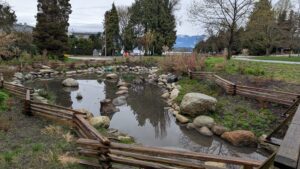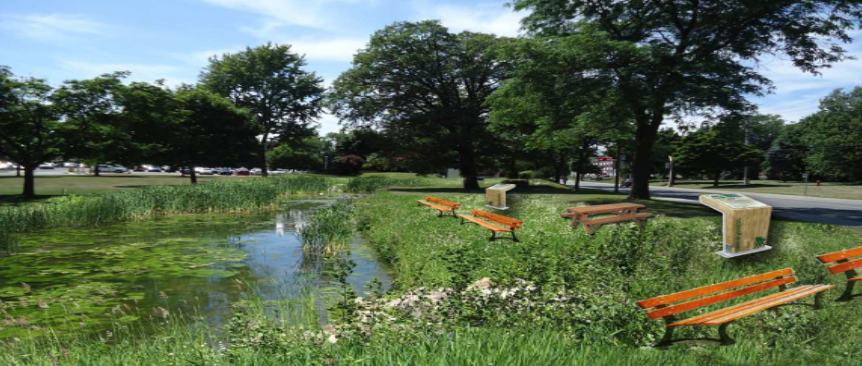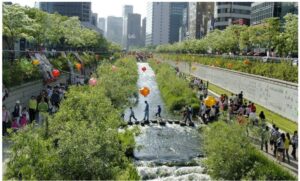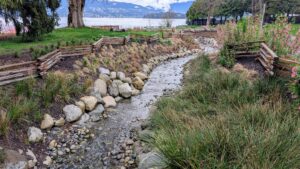Daylighting
 “Daylighting” is the inspirational term for restoration of an originally open-air watercourse which has been diverted below ground that can be turned back into an above-ground channel. Typically, the rationale behind returning a now hidden urban creek to a more natural state is to manage runoff and flooding, create habitat for native plants and animals and improve water quality through natural filtration.
“Daylighting” is the inspirational term for restoration of an originally open-air watercourse which has been diverted below ground that can be turned back into an above-ground channel. Typically, the rationale behind returning a now hidden urban creek to a more natural state is to manage runoff and flooding, create habitat for native plants and animals and improve water quality through natural filtration.


We believe that the earliest daylighting projects for hidden urban creeks took place almost concurrently in North America and in Europe.
The earliest documented daylighting project is Strawberry Creek in Berkeley, California which dates back to 1987. Its vision was to restore the ecological integrity of Strawberry Creek.
In Europe, the City of Zürich in Switzerland began to systematically daylight its urban creeks in 1988, and has since daylighted over 21km of these. This places the City of Zürich at the helm of daylighting practice globally. In Zürich’s case, daylighting commenced with one objective, namely to separate rainwater runoff from the sewer system in order to alleviate the pressure on the sewage treatment facilities and therefore decrease the cost of sewage treatment. Over time, however, the process led to enhancing the water quality and to integrating water as part of the public realm design.
 Cheonggyecheon is a 10.9-kilometre-long, modern public recreation space in downtown Seoul, South Korea. The massive urban renewal project is on the site of a stream that flowed before the rapid post-war economic development caused it to be covered by transportation infrastructure. The $900 million project initially attracted much public criticism but, since opening in 2005, has become popular among residents and tourists.
Cheonggyecheon is a 10.9-kilometre-long, modern public recreation space in downtown Seoul, South Korea. The massive urban renewal project is on the site of a stream that flowed before the rapid post-war economic development caused it to be covered by transportation infrastructure. The $900 million project initially attracted much public criticism but, since opening in 2005, has become popular among residents and tourists.
Saw Mill River has been one of the most daring river restoration projects on the East Coast of the USA. As the last vestiges of the urban industrial waterfront have been slowly erased from New York state’s post-industrial cities, many of its polluted rivers and waterways are finally being remediated and modernized, and in New York City, this has led to an impressive array of restoration projects. Wetlands are being replanted at Alley Creek, reforestation work is being completed along the Bronx River, Superfund cleanups have begun in the Newtown Creek and Gowanus Canal, marshes and parks are being created along the Harlem River, and new creeks are now being engineered in the Staten Island Bluebelt system. But the city has yet to daylight any of its buried rivers.
The UK’s most famous river restoration project is the clean-up of the River Lea for the London 2012 Olympics. At the same time, more than 17km of other waterways have been opened up (aka “deculverting” in the UK) across the capital since 2009. It is a trend being repeated across the UK, with the most recent example of daylighting coming in the centre of the Yorkshire city of Sheffield. London’s Lost Rivers project has documented dozens of tributaries of the Thames which now flow largely underground as a subterranean tangle of unseen streams. River restoration – the restoration of water flows and aquatic life to a largely ‘natural’ state – has been a topic of increasing interest over recent years, and organisations like the River Restoration Centre and the European Centre for River Restoration have formed to promote restoration work.
Canada’s own highly successful Project Paradise effort since 1993 to recover a healthy biodiversity around the bay, creeks and marsh areas adjoining Hamilton, Ontario. It was the last remaining wetland in the Hamilton/Burlington Area and largest on western Lake Ontario. Project Paradise was created to connect the Royal Botanical Gardens with community partners that have similar goals concerning restoration and stewardship. By 1985, 85% of the wetland’s plant cover had been lost, 90% of the remainder was non-native species, and the carp population numbered over 70,000 fish. As part of ongoing efforts to reverse this ecological decline, the Royal Botanical Gardens introduced Project Paradise in 1993, part of the Hamilton Harbour Remedial Action Plan. The plan focuses on removing sources of stress to the marsh by focusing attention on inflowing water pollution, minimizing the number of spawning carp, and re-establishing native plants. It continues to be supported by the federal and provincial governments through the Great Lakes Water Quality Agreement.
As part of ongoing efforts to reverse this ecological decline, the Royal Botanical Gardens introduced Project Paradise in 1993, part of the Hamilton Harbour Remedial Action Plan. The plan focuses on removing sources of stress to the marsh by focusing attention on inflowing water pollution, minimizing the number of spawning carp, and re-establishing native plants. It continues to be supported by the federal and provincial governments through the Great Lakes Water Quality Agreement.
Vancouver is nearing completion to “create an ecologically diverse stream” through Tatlow and Volunteer Parks that will feed into English Bay.


